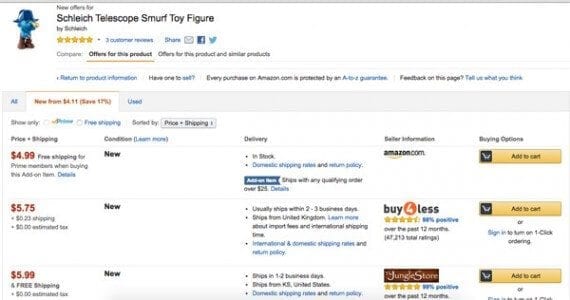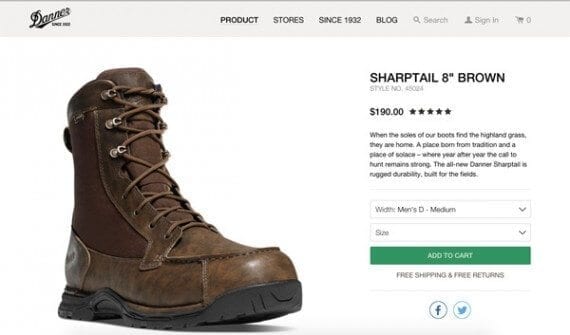Ecommerce continues to grow, representing an increasing share of total retail sales. As more and larger online stores open, small sellers may face new business-threatening problems in 2016.
Ecommerce has long been the small businessperson’s friend. The segment has a relatively low barrier to entry and can require relatively few employees or resources. While this will not likely change anytime soon, at least five current trends may represent significant problems for small ecommerce operations.
1. Competing on Price and Shipping
Online merchants often compete on price. For example, dozens or even hundreds of sellers may list identical products on marketplaces. All of these companies are vying to make a sale with nothing to differentiate their stores except price.

Some 18 different sellers, including Amazon proper, are offering this Smurf figure for sale on the Amazon Marketplace.
This sort of price competition has hurt some small retailers, which may not have the buying power to compete with mid-sized or large competitors. Add to this the pressure to offer free shipping on nearly every order, and price and shipping competition is a real problem for some stores.
In 2016, this problem will grow worse for the smallest businesses in the industry. Large online sellers like Amazon and Walmart have shipping facilities around the country. These distributed warehouses allow large ecommerce businesses to ship orders from the nearest facility, which for as many as 60 percent of orders is in the same metropolitan area the customer is in. When orders are shipped from these nearby warehouses, the cost to send the order can be substantially less and the order will frequently arrive with a day or two.
Bottom line, online shoppers will increasingly expect fast, free shipping — on top of the lowest price.
Small retailers will need to distribute their own inventory to fulfillment warehouses, become very efficient shippers, or find unique products to minimize this problem.
2. Competing against Manufacturers
Many small online stores buy products wholesale from manufacturers or distributors to sell at retail. This is the classic business model for retail stores.
Unfortunately, ecommerce’s low barrier to entry has encouraged many product manufacturers to start selling directly to consumers. This means that the same company that sells your products may also be your competitor. As an example, Danner Footwear, which is a division LaCrosse Footwear, sells not just wholesale to retailers, but also directly to consumers on its website.

Danner Footwear, a product manufacturer, is competing with its traditional customers — retailers — for ecommerce sales.
This problem will likely become worse in 2016 as more manufacturers start selling online. To counter this trend, small ecommerce retailers should look for unique or private label products to sell.
3. Selling in the Social Channel
Social media has long been heralded as a rising and powerful tool for marketers. By some standards, however, it has not yet lived up to its potential. This might change — to a degree — in 2016 for a few reasons.
Social is important for traffic and as an alternative to search. Some data suggests that Facebook and Pinterest are among the best sources for ecommerce traffic. There is even evidence that shoppers are starting to use these platforms to look for products. Add to this the outbreak of social media buy buttons and the channel may represent selling opportunities for ecommerce in 2016.
The problem for small online sellers is that this creates an additional selling channel to manage, if it becomes available at all. At the time of writing, Buyable Pins on Pinterest, as an example, were only available to select national brands or sellers using one of five preferred ecommerce platforms.
If social starts to represent a significant ecommerce channel, small merchants will have to learn to manage it and compete in it.
4. Customer Loyalty
Customer loyalty may be the most important area of focus for ecommerce businesses in the next couple of years. It is simply much more profitable to sell to loyal customers than it is to constantly seek out new ones.
As an example, in March 2015 The Washington Post published an article about how losing customers had hurt J.Crew.
“J. Crew is learning the hard way that in an era when ecommerce has presented women with ever-greater shopping choices, customer loyalty is hard to win and incredibly easy to lose,” wrote the article’s author, Sarah Halzack.
Small business owners and marketers rarely have the sort of resources available to large competitors. So these small stores will need to take extraordinary measures to retain shoppers.
5. Creating Content
Content marketing is more than a buzz. It is becoming an important marketing tactic for both getting new customers and engaging loyal ones. The best ecommerce content marketers are creating amazing how-to videos, industry-leading trend articles, and posts that offer real value.
Relatively large online stores may have entire teams devoted to creating compelling content.
It may be a problem for small retailers to keep up, but there is still hope. Even the smallest online stores can learn to produce customer-attracting content.




